Ever wonder where feral cats sleep after a long night of prowling?
Different from the friendly neighborhood stray or the outdoor pet that returns home at dinner, feral cats have limited or no interaction with humans, navigating life independently. (1)
They’re a bit like the ninjas of the cat world—sleek, stealthy, and seldom spotted during daylight hours.

Since feral cats prefer to keep to the shadows, often emerging at night or twilight to hunt and explore, finding a secluded and safe snoozing spot is key to their survival.
You might be intrigued to know that their sleeping arrangements are quite strategic.
Contrary to popular belief, these cautious creatures don’t just curl up anywhere; they seek environments that shield them from elements and predators alike.
Ready to curl up and learn? Here’s the lowdown on feline slumber habits in the wild.
Key Takeaways
- Feral cats are elusive, with nighttime and twilight being their prime time for activity.
- Their sleeping spots are carefully chosen to offer security and shelter.
- Understanding where and how feral cats sleep can lead to better strategies for supporting their welfare.
Discovering Where Do Feral Cats Sleep
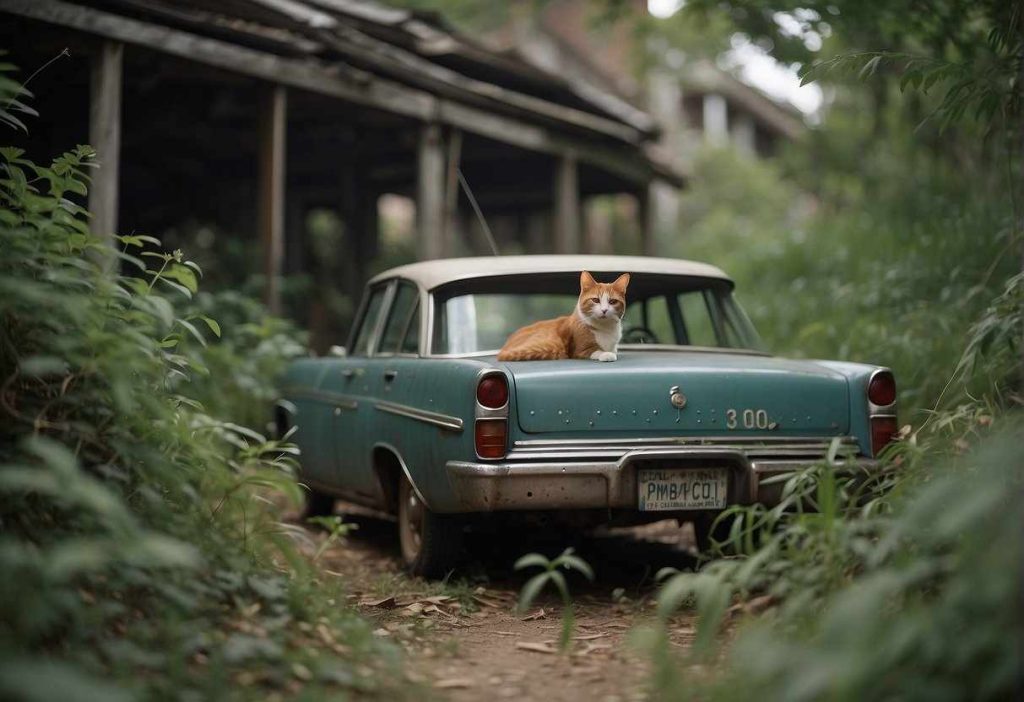
Your inquisitive nature is about to be rewarded as we uncover some snug spots where feral cats slumber.
Behavioral Patterns Influencing Sleeping Spots
Feral cats have a strong instinct to dodge danger. (2)
Safety is their top priority when picking out a bedroom.
Imagine yourself in their paws—you’d want a spot out of reach from pesky predators, right?
Often, they’ll seek out heights or tuck themselves away in secluded nooks. It’s all about being invisible to uninvited guests.
Common Resting Places for Feral Cats
In the lush lap of nature, feral cats are likely to snuggle into dense foliage or, perhaps, find a cozy tree hollow to shield them from the elements.
Transition to the city, and their sleeping quarters get a concrete makeover.
Abandoned buildings, secretive spots beneath decks, or even the occasional abandoned car; if it’s quiet and sheltered, it’s on their list.
Natural vs. Urban Environments
- Natural:
- Dense foliage
- Underbrush
- Tree hollows
- Urban:
- Abandoned buildings
- Underneath decks
- Abandoned cars
Human-made Shelters and Contributions
You’re not the only one concerned about where these furry vagabonds bed down for the night.
Generous souls in communities are stepping up, crafting insulated cat houses, and tweaking storage bins into cozy cribs.
A hole for an entrance and a bed of straw—that’s five-star accommodation in the feral world.
Then, let’s not overlook the broader canvas of human compassion.
Neighborhoods band together, pooling resources to erect these life-saving shelters, providing not just warmth but a touch of love to the stray whiskered wanderer.
Consider this: your simple act of kindness could turn a cold corner into a warm bed for a feral friend tonight.
Enhancing Safety and Comfort for Feral Cats
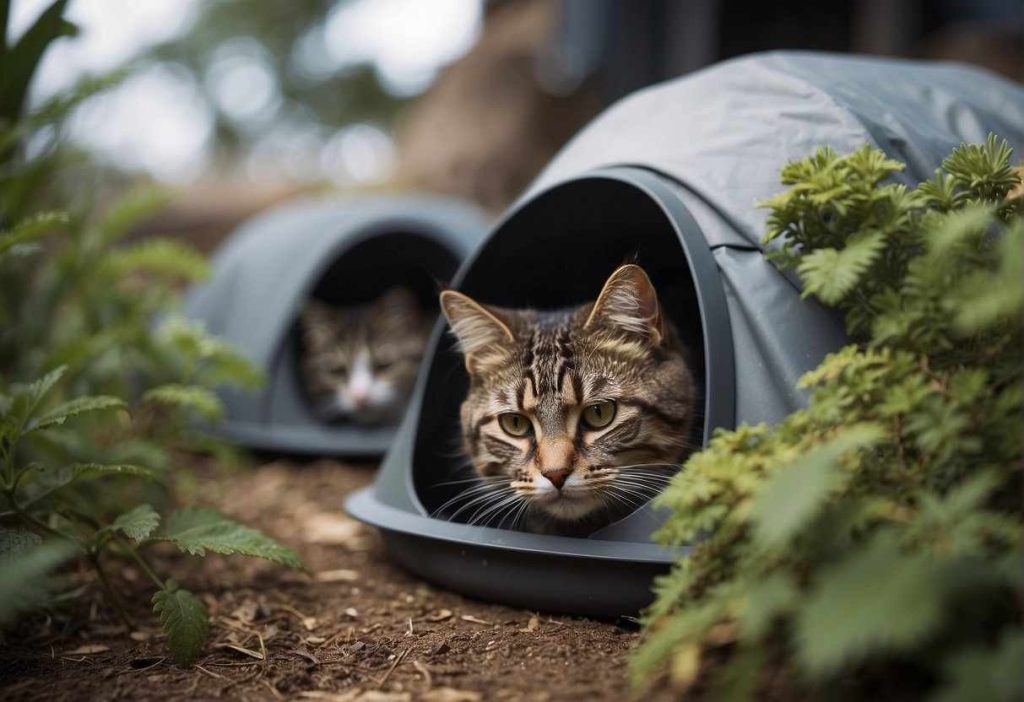
Let’s get crafty with shelters. Trust me, it’s easier than assembling that nightstand from the Swedish furniture store.
Building and Maintaining Outdoor Shelters
Why not get your hands dirty for a good cause? You can build a feral cat pad using stuff that might be lying around your garage. Here’s a quick DIY Shelter Building 101:
- Grab some wood, sturdy styrofoam, or repurposed containers.
- Insulation is key—straw is your go-to buddy. It’s like a warm hug keeping the chill out!
Remember, straw, not hay. We want cozy, not a soggy mess.
Now, add a touch of love:
- Measure and cut the materials to create a small, snug shelter.
- Seal the edges to fend off the drafts.
- Straw layers on the bottom—like a cherry on top (but underneath).
Addressing Health and Safety Risks
Poor little furballs face the big baddies out there—traffic, two-legged monsters, curious canines, and weather tantrums.
How can you help?
Create a regular feeding station, away from these dangers: (3)
- It keeps them from dumpster-diving in risky spots.
- Regular food times mean healthier and happier felines. (4)
It’s like you’re their guardian angel—minus the wings and halo.
Keep an eye on your whiskered friends, and they’ll be purring in their new safe abodes in no time!
Legal, Ethical, and Community Aspects of Feral Cat Care
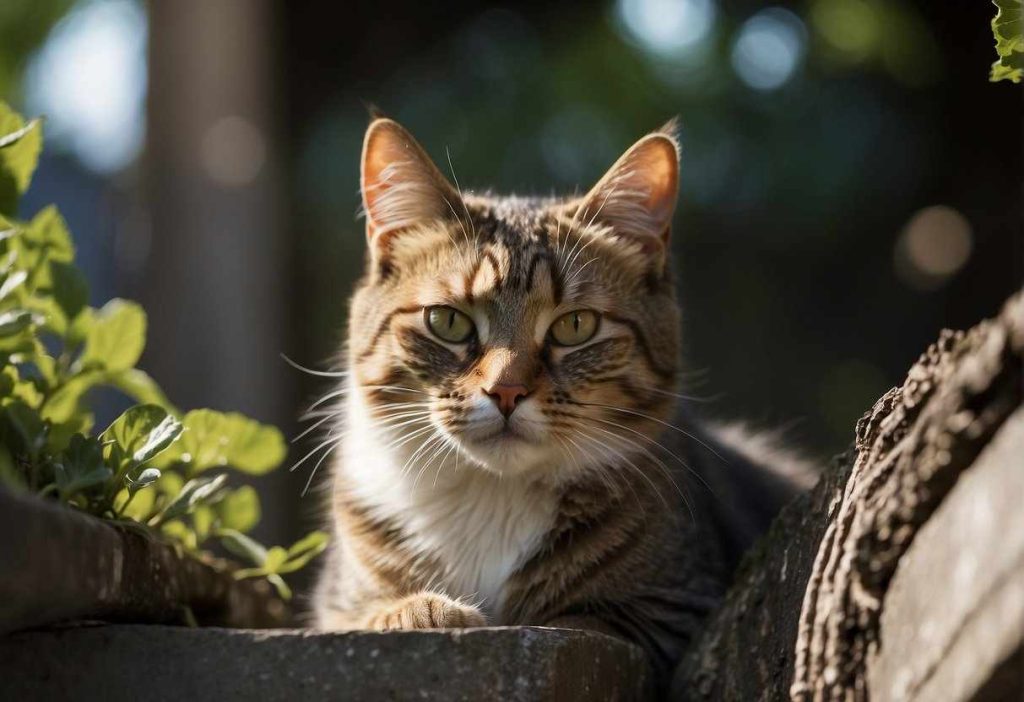
Community Involvement in Feral Cat Welfare
You might wonder, “What can I do for feral cats in my area?” Getting involved with local Trap-Neuter-Return (TNR) programs is a fantastic start.
These programs are not just about controlling populations; they involve community education and humane care. Here’s how you can be a part of the solution:
- Educate yourself and others about TNR and its benefits. (5)
- Volunteer with local TNR efforts.
- Donate to organizations that support feral cat welfare.
- Advocate for effective and humane feral cat policies.
Building Trust with Feral Cats
Here are some tips to build trust with these elusive felines:
- Start with gradual feeding to establish a routine.
- Provide shelter and care without expecting immediate trust.
- Respect their space and autonomy.
Legal and Ethical Considerations
Curious about your city’s stance on feral cats? Check out your local ordinances:
- Some places have feeding bans to deter feral cat gatherings.
- Others support TNR, recognizing its role in humane population control. (6)
Ethically, it’s vital to tread carefully when interacting with feral cats.
Always prioritize their well-being and consider the most humane options for intervention.
Remember, although these cats are independent, they still deserve our compassion and respect.
Advanced Strategies for Supporting Feral Cats
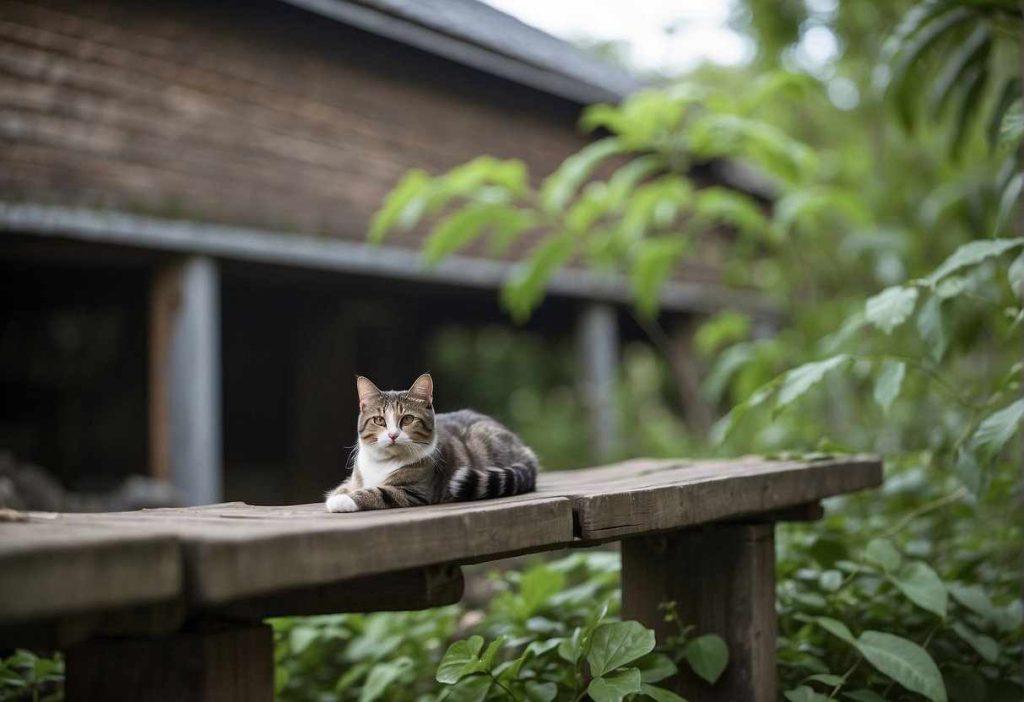
Expert Insights on Feral Cat Care
Healthcare: Vets suggest regular deworming and vaccinations to keep these free spirits healthy.
Winter Survival: Insulated shelters can be lifesavers during cold spells.
Emergency Care: For the unlucky cat who has a run-in with danger, knowing how to handle injuries is crucial.
Case Studies and Success Stories
Communities with TNR (Trap-Neuter-Return) successes are goldmines of inspiration. Here’s what they’ve achieved:
- Impact on Local Wildlife: Fewer feral felines mean more birds and small mammals can thrive. (7)
- Nuisance Complaint Reduction: Noisy mating calls? Gone. Unpleasant scents? A thing of the past.
- Health Improvements: These cats are now sporting glossy coats and brighter eyes, thanks to better care.
Practical Tutorials
Roll up your sleeves—it’s DIY time!
- Shelter Building: Get crafty and construct cozy retreats with just a few supplies.
- Feeding Stations: Learn to design a dining spot that doesn’t ruffle feathers—literally—with the other critters.
- Safe Trapping: Ready to be a TNR hero? We’ve got the step-by-step to do it right.
You got this! With a dash of compassion and a sprinkle of knowledge, you’re well on your way to becoming a feral cat’s superhero.
Quick Recap
Feral cats are resourceful snoozers, and you can find them in various nap nooks. Let’s break it down:
- Sheltered Spaces: Your garden shed or that abandoned garage down the street? Prime real estate for feral feline R&R.
- Natural Cover: Bushes and grass provide excellent camouflage and protection.
- Urban Hideaways: Empty containers, unused cars, or crawl spaces under buildings can be purr-fect snooze spots.
But why should you care where feral cats nap? It’s about more than a cozy catnap; it’s about their welfare—and ours too. Here’s the skinny:
- Health: Undisturbed rest is vital for their well-being.
- Safety: A safe sleeping area keeps them away from potential threats.
- Community: Understanding their behavior helps us live harmoniously together.
Want to chip in? Think about this:
- Education: Learn and share info on feral cat behavior.
- Engagement: Get to know local feral cats – snap pics, but respect their space!
- Care: Consider supporting trap-neuter-release programs.
Together, with a dollop of knowledge and a sprinkle of compassion, we can create comfy communities for our feline friends and us. Ready to lend a paw?
Frequently Asked Questions
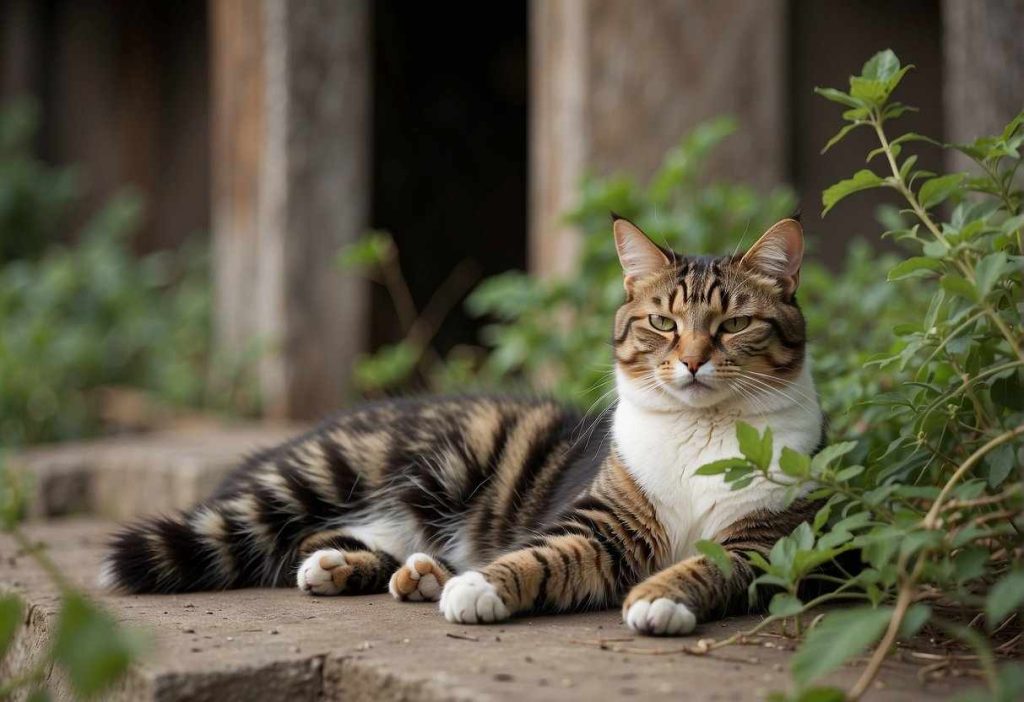
Curiosity often sparks a desire to learn more about feral cats, especially regarding their rest routines. Discover how these elusive creatures find comfort in the harshness of the outdoors.
What are the essential components of a good outdoor shelter for feral cats?
A good outdoor shelter for feral cats should be insulated, waterproof, and equipped with straw bedding to keep them dry and warm.
Ventilation is crucial to prevent moisture buildup which can lead to cold conditions.
Where do feral cats usually sleep in urban environments?
In urban areas, feral cats often seek out quiet, secluded spots, such as abandoned buildings, beneath parked cars, or in empty lots filled with debris that offer shelter from predators and harsh weather.
What are the cozy spots feral cats choose for their daytime naps?
During the day, feral cats often nap in locations that receive ample sunlight yet provide seclusion, like sunny spots in a garden, on a warm pavement, or in a deserted outbuilding.
At the end of their nine lives, where can feral cats typically be found?
Feral cats, at the end of their time, usually seek out the most hidden and quiet places they’ve found comfort in throughout their lives.
This could be anywhere from dense foliage to a familiar abandoned structure.
What’s the perfect bedding material that feral cats adore for their sleep?
Straw is the preferred bedding for feral cats. Unlike blankets or hay, straw doesn’t retain moisture, thereby keeping the cats warm and dry through cold nights.
Are there any particular places feral cats frequent for their night-time adventures?
Night-time adventures usually take feral cats to places with potential food sources like alleys with dumpster bins, or areas known for rodent activity.
Safety remains a priority; therefore, they opt for shadowy and quiet routes.
What legal considerations should I be aware of when caring for feral cats?
When caring for feral cats, you should check local regulations concerning feeding, sheltering, and managing these animals.
Some areas have Trap-Neuter-Return (TNR) programs in place to help maintain the feral cat population responsibly.


